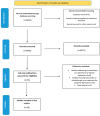The Use of Phototherapy for the Treatment of Non-Seasonal Depression: A Systematic Review of Efficacy and Safety
- PMID: 40095880
- PMCID: PMC11900944
- DOI: 10.3390/jcm14051756
The Use of Phototherapy for the Treatment of Non-Seasonal Depression: A Systematic Review of Efficacy and Safety
Abstract
Background: Phototherapy, which has traditionally been used for seasonal affective disorder, is now being investigated for its effectiveness in treating non-seasonal depression. This systematic review aims to evaluate the efficacy and safety of phototherapy in this new context, providing a comprehensive overview of its therapeutic potential and limitations. Methods: The review followed PRISMA guidelines and included studies from databases such as Google Scholar, PubMed, and UpToDate. Studies were selected based on their focus on phototherapy's efficacy, safety, and application methods for non-seasonal depression. Various administration methods were examined, particularly the effects of multiple daily sessions and personalized treatment plans. Results: The findings indicate that while phototherapy alone has limited effectiveness, combining it with antidepressants significantly improves outcomes. The most effective protocols featured multiple daily sessions tailored to individual patient needs, even at lower light intensities. Safety assessments have shown that phototherapy is well tolerated, with no serious side effects reported, only minor and transient reactions. Conclusions: Phototherapy appears to be a promising adjunct therapy for non-seasonal depression, offering safety and flexibility in treatment customization. It provides consistent therapeutic benefits, mainly when used in conjunction with conventional antidepressant treatments.
Keywords: non-seasonal depression; phototherapy; safety profile; treatment efficacy.
Conflict of interest statement
The authors declare no conflicts of interest.
Figures
References
-
- Lam R.W., Levitt A.J., Levitan R.D., Michalak E.E., Cheung A.H., Morehouse R., Ramasubbu R., Yatham L.N., Tam E.M. Efficacy of Bright Light Treatment, Fluoxetine, and the Combination in Patients With Nonseasonal Major Depressive Disorder: A Randomized Clinical Trial. JAMA Psychiatry. 2016;73:56–63. doi: 10.1001/jamapsychiatry.2015.2235. - DOI - PubMed
Publication types
LinkOut - more resources
Full Text Sources



